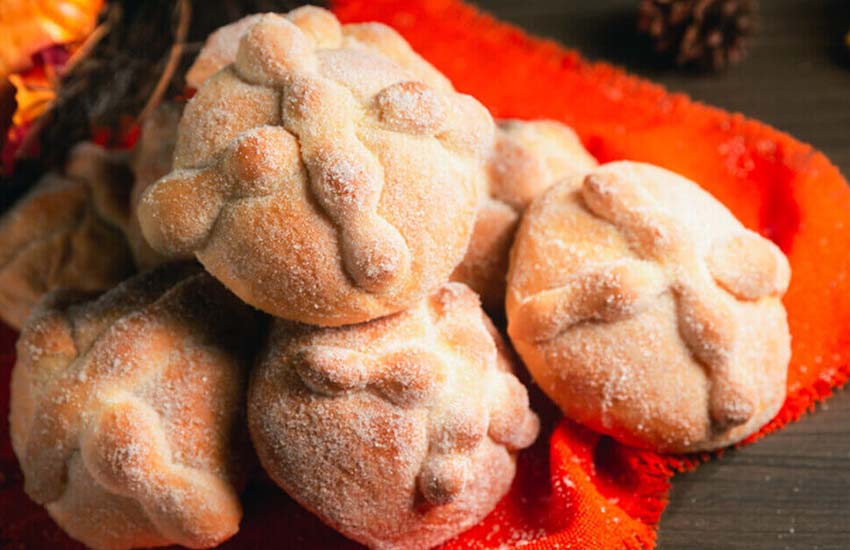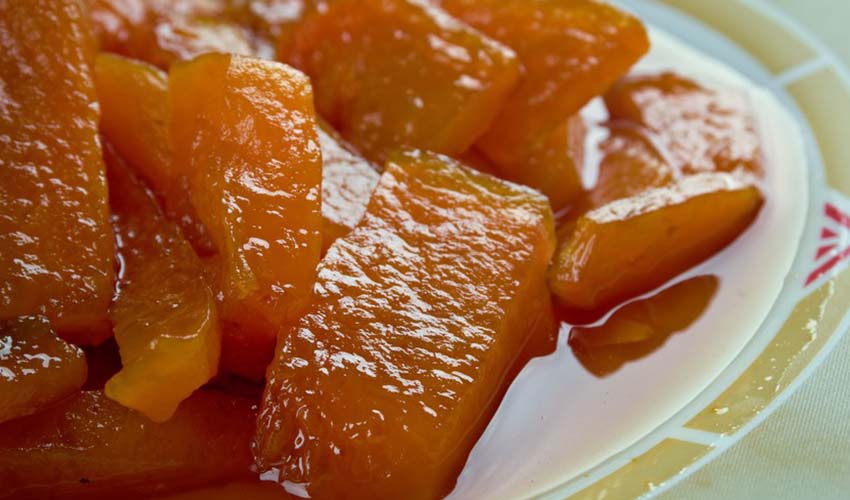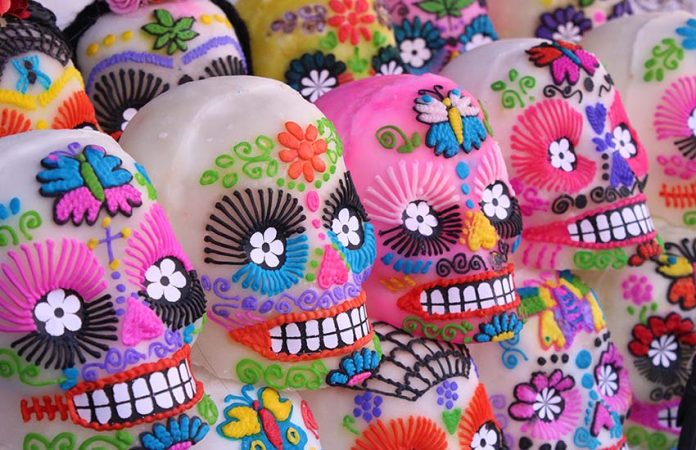Like every holiday, Día de Muertos is celebrated with food.
In this case, though, the foods aren’t necessarily what we want: Day of the Dead tradition calls for honoring those who have passed away by preparing their favorite dishes and drinks, uniting both worlds in a celebration and remembrance of your time with them. Relatives and friends cook for the pleasure of the departed, and offerings are made on home altars or at grave sites. Marigolds (cempasuchitl) are traditionally used for decoration as their strong fragrance is said to attract and guide the spirits back to their final resting place.
Pan de muerto (literally translated as “dead bread”) is perhaps the most well-known food associated with this holiday and heralds the approaching celebration. While it seems to be just a round, Danish-like pastry sprinkled with sugar, everything about it is symbolic.
The circular shape represents the cycle of birth and death; the bumpy knob on top represents the skull, with the four elongated knobby strips symbolizing bones or the tears shed for the deceased.

These also signify the four directions of the Aztec calendar. And finally, Pan de Muerto’s gentle orange-blossom flavor is to attract and comfort the deceased. While you’ll find different variations throughout Mexico, the basic shape and meanings remain the same.
Pan de muerto can be made at home — it’s a basic sweet yeast dough — but space restrictions prohibit my including a recipe here. Google around or just go buy some at your favorite bakery or restaurant.
Candy skulls (calaveras or calaveritas) are another sweet traditionally associated with Day of the Dead. Made from just sugar, egg whites and water, they aren’t usually eaten (even though they could be) and are simply for decoration. They’re a fun project if you’re so inclined, although they are easily purchased in grocery stores at this time of year.
Amaranth candies, or alegría — made plain or with nuts and seeds or chocolate — are another sweet often found on Day of the Dead altars. These are easy (and delicious) to make and can be cut into relevant shape. Find recipes for traditional alegría and a chocolate version here.
Pumpkins—or calabaza—come into the picture during this time too, albeit not in the form of pie or lattés. Slow-cooked in a thick sugar syrup, Dulce de Calabaza (recipe below) celebrates the season and is meant to appeal to the sweet tooth of loved ones who have passed away.
Sugar Skulls (Calaveritas)
To make the skulls:
- 3 cups granulated sugar
- The white of 1 large egg
In a bowl, combine sugar and egg white with your fingers. Pack mixture firmly into skull molds. Scrape tops level. Bake at 200 F (93 C) for 20–30 minutes until surface feels hard and solid when lightly pressed. Cool on wire rack.
To unmold: place a baking sheet over the mold; holding mold and pan together, turn over. Tap mold gently and then lift carefully off sugar skulls.
If mixture sticks to mold, dump back into bowl and stir in 2–4 tablespoons sugar; if mixture crumbles, return to bowl and mix in more egg white, 1 teaspoon at a time. If any skulls break, wash and dry mold and fill again, reusing sugar mixture.
To make icing:
- The white of 1 large egg
- 1/8 tsp. cream of tartar (optional)
Using a mixer on high speed, beat the egg white and cream of tartar (if available) until foamy. Beat in 1½ cups powdered sugar. Add more if needed to make a stiff icing. Blend in food coloring as desired.
Pipe icing onto cooled skulls to decorate, using a pastry bag with plain or decorative tips. Let dry at least 1 hour.
Store in airtight container or wrapped in plastic.

Dulce de Calabaza
You’ll see this in the mercados in a more crystalized form, to eat as candy.
- About 5 cups peeled,* seeded and cubed calabaza, butternut squash or pumpkin
- 1 cup piloncillo, grated
- 1 tsp. cinnamon or 1 (4-inch) cinnamon stick
- 1 cup water
Heat water, cinnamon and piloncillo in a pot big enough to fit all the squash. Simmer over medium heat until piloncillo dissolves; add squash pieces. Continue simmering, stirring occasionally, until syrup is thick as honey. Serve warm, topped with a scoop of vanilla ice cream or plain yogurt.
* To peel squash or pumpkin: place whole squash/pumpkin on folded dish towel so it doesn’t slip. Carefully cut in half, then quarters (or in smaller slices). Remove seeds. To peel, use a vegetable peeler or a sharp paring knife. Cut into cubes and proceed with recipe.
Oaxacan Fruit Atole
Find more atole recipes here.
- 5 cups milk
- ½-¾ cup sugar
- 1 lb. any kind of fruit (apples, pears, plums or mixed)
- A 4-inch long cinnamon stick
- 1/8 tsp. baking soda
- ½ cup harina de maiz (corn flour)
- About 1 cup water
Wash, cut and boil fruit in water until soft. Strain out skins, pits and seeds. Purée in blender or food processor.
Combine puréed fruit, milk, sugar and baking soda in a pan. Dissolve corn flour in water; add to pan.
Cook over low heat, stirring constantly, until it thickens. Add sugar to taste before mixture begins to boil.
Remove from heat. Serve warm or chilled.
Alegría de Limón (Lime Amaranth Candy)
- 5 cups amaranth
- 1½ cups sugar
- ¾ cup water
- 2 Tbsp. grated piloncillo
- 1¼ Tbsp. lime juice
- ¼ cup water
- Vegetable oil spray
- Optional: pepitas, peanuts, sunflower seeds
Lightly spray cupcake tin, 8×8-inch baking pan, rimmed baking sheet or other molds with vegetable oil. Place amaranth in large bowl.
In a saucepan, heat ¾ cup water, sugar, piloncillo and lime juice over medium-high heat. Boil 10–15 minutes, stirring continuously.
Pour syrup over amaranth; mix well with a spatula or spoon. Scoop mixture into pan or molds; press down firmly to even out surface.
If using the nuts, scatter over the top and press into the amaranth mixture. If using baking sheet or pan instead of molds, cut into any desired shape while warm. Store in sealed container in refrigerator.
Janet Blaser is the author of the best-selling book, Why We Left: An Anthology of American Women Expats, featured on CNBC and MarketWatch. She has lived in Mexico since 2006. You can find her on Facebook.
